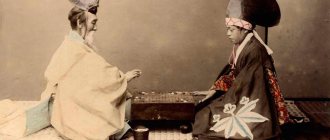Thanks to information technology, the modern world has become much more accessible. And we began to travel more. The culture and traditions of various countries are no longer a mystery.
Something surprises us, something is categorically not suitable for our mentality, something we gladly adopt, including methods of raising children.
One of the most original and unlike us countries is Japan. Many customs and traditions that are common to the Japanese are unusual for us, including being raised in Japanese.
Everything has its time
The period of “permissiveness” in a child lasts only up to 5 years. Before this age, the Japanese treat the child “like a king,” from 5 to 15 years old, “like a slave,” and after 15, “like an equal.” It is believed that a fifteen-year-old teenager is already an adult who clearly knows his responsibilities and impeccably obeys the rules. This is the paradox of Japanese upbringing: a child who was allowed everything in childhood grows into a disciplined and law-abiding citizen. However, there is no need to rush to transfer Japanese education methods into Russian reality. It would be wrong to consider them in isolation from the worldview and way of life of the Japanese.
Yes, young children in this country are allowed everything, but at 5-6 years old the child finds himself in a very strict system of rules and restrictions that clearly dictate how to act in a given situation. It is impossible not to obey them, since everyone does this, and to do otherwise means to “lose face” and find yourself outside the group. “There is a place for everything” is one of the basic principles of the Japanese worldview. And children learn it from a very early age.
Basic principles of the Japanese worldview
Japanese children, already at preschool age, learn the principle that everything in this world has its place. This is not always easy for kids. So it is hardly necessary to transfer their customs to us.
In general, a family of 4 people is considered the norm. The main one is the father or shujin . The wife plays the role of a housewife. It is called kanai , which means "inside the house". Now this division is gradually smoothing out and more and more women are going to work. Much attention is paid to the birth order of children. The eldest is the heir. He is responsible for most of the responsibilities.
The situation with marriages is interesting. More often, parents themselves agree on the wedding of their children and find life partners for them. Fortunately, this rule is gradually disappearing into oblivion. Divorce is not welcomed in society and happens extremely rarely.
Tradition and modernity
The traditional Japanese family is a mother, father and two children. Previously, family roles were clearly differentiated: the husband was the breadwinner, the wife was the keeper of the hearth. The man was considered the head of the family, and everyone in the household had to obey him unquestioningly. But times are changing. Recently, the influence of Western culture has been felt, and Japanese women are increasingly trying to combine work and family responsibilities. However, they are still far from equal rights with men. Their main occupation is still home and raising children, and the man’s life is absorbed by the company in which he works.
This division of roles is reflected even in etymology. A commonly used word for wife is the noun kanai, which literally translates to “inside the house.” And it is customary to address a man as shujin - “main man”, “master”. Subordination can also be seen in relationships with children. There are no words for "brother" and "sister" in Japanese. Instead they say ani ("elder brother") and otooto ("little brother"), ane ("elder sister") and imooto ("little sister"). Therefore, the idea of superior and inferior never leaves the child’s consciousness. The eldest son is noticeably distinguished from the rest of the children, he is considered the “heir to the throne,” although the throne is just the parental home. The older child has more rights, but accordingly more responsibilities.
Previously, marriages in Japan were arranged by arrangement: husband and wife were chosen by parents, taking into account social and property status. Nowadays, Japanese people are increasingly marrying out of mutual sympathy. But parental duty clearly takes precedence over emotional ties. There are also divorces in Japan, but the percentage is much lower. This is reflected in the Japanese's orientation toward group consciousness, in which the interests of the group (in this case, the family) are placed above the individual.
The mother is responsible for raising the child. The father can also participate, but this is rare. Amae is what mothers are called in Japan. It is difficult to find an analogue for this word in Russian. It means a feeling of dependence on the mother, which is perceived by children as something desirable. The verb amaeru means “to take advantage of something,” “to be spoiled,” “to seek protection.” It conveys the essence of the relationship between mother and child. When the baby is born, the midwife cuts a piece of the umbilical cord, it is dried and placed in a traditional wooden box slightly larger than a matchbox. The name of the mother and the date of birth of the child are engraved on it in gilded letters. This is a symbol of the connection between mother and baby.
In Japan, you rarely see a baby cry. The mother tries to make sure that he has no reason for this. For the first year, the child remains, as it were, part of the mother’s body, who carries him tied behind her back all day, puts him to sleep next to her at night, and gives him the breast at any time he wants. The Japanese industry even produces special jackets with a zipper insert that allow you to carry a child in front. When the baby grows up, the insert comes off and the jacket turns into regular clothing.
The child is not prohibited from doing anything; from adults he only hears warnings: “dangerous,” “dirty,” “bad.” But if he does get hurt or burned, the mother considers herself to blame and asks him for forgiveness for not saving him.
When children begin to walk, they are also practically not left unattended. Mothers continue to follow their little ones literally on their heels. They often organize children's games, in which they themselves become active participants.
Dads only go for walks on weekends, when the whole family goes to the park or nature. And in bad weather, large shopping centers with game rooms become places for family leisure.
Boys and girls are raised differently because they have to fulfill different social roles. One of the Japanese proverbs says: a man should not enter the kitchen. They see the son as the future support of the family. On one of the national holidays - Boys' Day - images of colorful carp are raised into the air.
This is a fish that can swim against the current for a long time. They symbolize the path of the future man, capable of overcoming all life's difficulties. Girls are taught to do housework: cook, sew, wash. Differences in upbringing also affect school. After lessons, boys always attend various clubs where they continue their education, and girls can sit quietly in a cafe and chat about outfits.
Why do the Japanese almost never get sick?
Let’s say right away: modern science does not give us an exact answer to this question. For a long time there was an opinion that it was all about genes, but today scientists have proven that this is not so.
Here's what Dr. Robert Vogel, a professor at the University of Maryland School of Medicine, says: “Genes don't seem to have anything to do with it. We studied statistics on cardiovascular diseases among Japanese men living in Japan, as well as in Honolulu and San Francisco, America. It turned out that life expectancy and the incidence of heart attacks and strokes among ethnic Japanese living in the United States coincide with similar indicators among representatives of other ethnic groups inhabiting the Hawaiian Islands and the state of California.”
French doctors came to the same conclusions. The head of a research group at the Lyon State Research Center that studied the connection between the Mediterranean diet and the prevention of heart disease, Michel de Lorgeril, is convinced: “Genetic characteristics do not serve as insurance against disease for the Japanese.”
Perhaps one of the reasons that the Japanese live longer than other peoples is the presence of a developed healthcare system that guarantees every citizen high-quality free medical care. As part of the fight against the threat of cardiovascular diseases in the country, several national campaigns have been carried out to persuade the population to reduce their salt intake.
Great attention is paid to disease prevention: government-funded medical examinations are regularly conducted in schools and other institutions. In addition, one should not discount the traditional Japanese cleanliness, thanks to which Japan has been able to significantly reduce the rate of infant mortality and childhood infectious diseases.
The Japanese lifestyle also plays a role. Japanese society is incredibly close-knit. Representatives of different social groups traditionally maintain the closest ties with each other, and the concept of ikigai, which means “the purpose of life,” is firmly rooted in the collective consciousness. All kinds of competitions for erudition and ingenuity are extremely popular, which helps the Japanese relieve stress successfully and without any medications.
University of Tokyo professor Kenji Shibuya, together with colleagues from the Ministry of Health, identify three factors that, in their opinion, explain why the Japanese live longer than all other peoples on our planet.
“Firstly, the Japanese pay increased attention to personal hygiene. This habit may be related to the climate - humid and hot in some areas of the country, and perhaps to the traditional Japanese religion of Shinto, which requires a person to undergo a procedure of cleansing the body and mind before meeting other people. Secondly, the Japanese are conscious about their health and are not lazy to undergo preventive medical examinations in due time. This allows for early diagnosis of diseases and increases the chances of their successful treatment. Thirdly, Japanese cuisine is characterized by maximum balance of nutrients. The higher the country's economic growth, the better the Japanese population eats."
The worst thing is loneliness
The Japanese never raise their voices at children, do not lecture them, not to mention corporal punishment. A widely used method can be called the “threat of alienation.” The most severe moral punishment is excommunication from home or pitting the child against some group. “If you behave like this, everyone will laugh at you,” the mother says to her naughty son. And for him this is really scary, since the Japanese cannot imagine himself outside the team. Japanese society is a society of groups. “Find a group to which you belong,” the Japanese morality preaches. - Be faithful to her and rely on her. Alone you will not find your place in life; you will get lost in its intricacies.” This is why loneliness is very difficult for the Japanese, and separation from home is perceived as a real disaster.
A Japanese woman never tries to assert her power over children, since, in her opinion, this leads to alienation. She does not argue with the will and desire of the child, but expresses her dissatisfaction indirectly: she makes it clear that she is very upset by his unworthy behavior. When conflicts arise, Japanese mothers try not to distance themselves from their children, but, on the contrary, to strengthen emotional contact with them. Children, as a rule, idolize their mothers so much that they feel guilty and remorseful if they cause them trouble.
Early development
The Japanese were among the first to talk about the need for early development. Half a century ago, the book “After Three It’s Too Late” was published in the country, which revolutionized Japanese pedagogy. Its author, Masaru Ibuka, is the director of the Talent Training organization and the creator of the world famous company Sony. The book says that in the first three years of life, the foundations of a child’s personality are laid. Young children learn everything much faster, and the task of parents is to create conditions in which the child can fully realize his abilities. In education, it is necessary to follow the following principles: stimulate cognition through arousing the child’s interest, cultivate character, promote the development of creativity and various skills. At the same time, the task is not to raise a genius, but to give the child such an education that “he has a deep mind and a healthy body, to make him smart and kind.” Now this point of view seems obvious, but in the mid-1950s it sounded revolutionary.
Hatsu-Zekku (First Festival)
Hinamatsuri (girls' festival) is a special day for girls, celebrated on March 3rd every year. Children's first hinamatsuri is especially valued. For the first time, a hina doll is being decorated and displayed in her name. She symbolizes her parents' desire for her to grow up happy and healthy. On this day, the family can enjoy special sweets, sushi and other treats.
Hinamatsuri: Celebrating Girls' Day in Japan
The equivalent for boys is Children's Day, which is celebrated annually on May 5th. The day used to be called Boys' Day and retained that theme (similar to February 23rd). On this day, families traditionally display their samurai dolls and display koinobori (carp-shaped ribbon) as a symbol of strength and vitality.
Let's go to kindergarten
Typically, a Japanese mother stays at home until the baby is three years old, after which he is sent to kindergarten. There are also nurseries in Japan, but raising a small child in them is not encouraged. According to everyone, children should be looked after by the mother. If a woman sends her child to a nursery and goes to work, her behavior is often seen as selfish. Such women are said to be insufficiently devoted to their family and put their personal interests first. And in Japanese morality, the public always prevails over the personal.
Learning from the Japanese: how to raise a child
The whole world knows that Japanese children are smart, diligent, responsible and in many ways ahead of their peers from other countries.
Natural... Vera Trakhimovich Feb 1, 2016
Love 1731
School in Japan is a place where discipline is observed and a restrained atmosphere reigns. Children wear a uniform regulated by the educational institution (winter and summer versions are sewn to order). At the end of classes, cleaning the school grounds and the school falls on the shoulders of the students, since there are no cleaners here. The principle regulated by primary and secondary schools is social equality. “Be like everyone else!” – this is what the Japanese school system teaches.
Very similar to what we had in the Soviet Union. Is not it?
Types of kindergartens
Kindergartens in Japan are divided into public and private. Hoikuen is a state-run nursery school that accepts children from three months of age. It is open from 8am to 6pm and half a day on Saturday. To place a child here, you need to justify this with very compelling reasons. In particular, bring documents stating that both parents work more than 4 hours a day. Children are placed here through the municipal department at their place of residence, and payment depends on family income.
Another type of kindergarten is etien. These gardens can be either public or private. The children are here for no more than 7 hours, usually from 9 am to 2 pm, and mother works less than 4 hours a day.
A special place among private gardens is occupied by elite ones, which are under the tutelage of prestigious universities. If a child ends up in such a kindergarten, then there is no need to worry about his future: after it he enters a university school, and from there, without exams, to the university. A university diploma is a guarantee of a prestigious and well-paid job. Therefore, it is very difficult to get into an elite kindergarten. It costs parents a lot of money to admit their child to such an institution, and the child himself must undergo quite complex testing.
Oshichiya Meimei Shiki (Baby Naming Ceremony)
According to Chinese characters (七, shichi, meaning 7 and 夜, ya, meaning night), oshichiya is traditionally performed on the 7th night after birth. The child's name is announced to the close congregation (usually just a few close relatives) and written in calligraphy on a scroll or card. The baby will be dressed in white (usually newborns are dressed in white until 17 days old), and guests will present monetary gifts and partake in a celebratory meal.
Interior
The situation inside the kindergarten looks, by our standards, very modest. Upon entering the building, the visitor finds himself in a large corridor, on one side of which there are sliding windows from floor to ceiling, and on the other - sliding doors (entrance to the rooms).
As a rule, one room serves as a dining room, a bedroom, and a study area. When bedtime comes, caregivers take futons—thick mattresses—from the built-in closets and lay them out on the floor. And during lunch, tiny tables and chairs are brought into the same room from the corridor.
Food
Special attention is paid to nutrition in kindergartens. The menu is carefully developed and necessarily includes dairy products, vegetables and fruits. The vitamin and mineral composition of dishes and their calorie content are calculated. If the kindergarten goes on a walk or excursion for the whole day, each mother should prepare an obento - a lunch box - for her child. But if in such cases we limit ourselves to a cutlet with vegetables or just sandwiches, then the art of the Japanese mother is worthy of admiration. Such a lunch must meet the mandatory requirements, namely: include 24 (!) types of products, the rice must be sticky and not fall apart, and there must be no beets present. It is advisable not to buy all the food in the store, but to prepare it with your own hands and beautifully arrange it in a box so that the child also receives aesthetic pleasure.
Relationships in the team
Groups in Japanese kindergartens are small: 6 - 8 people. And every six months their composition is reorganized. This is done in order to provide children with greater opportunities for socialization. If a child does not have good relationships in one group, then it is quite possible that he will make friends in another.
The teachers are also constantly changing. This is done so that children do not get used to them too much. Such attachments, the Japanese believe, give rise to children's dependence on their mentors. There are situations when some teacher dislikes a child, but a good relationship develops with another teacher.
What classes are offered in kindergarten? Children are taught to read, count, write, that is, they are prepared for school. If the child does not attend kindergarten, such preparation is carried out by the mother or special “schools” that resemble Russian clubs and studios for preschoolers. But the main task of a Japanese kindergarten is not educational, but educational: to teach the child to behave in a team . In later life he will have to constantly be in some kind of group, and this skill will be necessary. Children are taught to analyze conflicts that arise in games. At the same time, you should try to avoid rivalry, since the victory of one may mean the “loss of face” of the other. The most productive solution to conflicts, according to the Japanese, is compromise. Even in the ancient Constitution of Japan it was written that the main dignity of a citizen is the ability to avoid contradictions. It is not customary to interfere in children's quarrels. It is believed that this prevents them from learning to live in a group.
Choral singing occupies an important place in the education system. According to Japanese ideas, singling out a soloist is not pedagogical. And singing in chorus helps foster a sense of unity.
After singing, it’s time for sports games: relay races, tag, catch-up. It is interesting that teachers, regardless of age, participate in these games along with children.
About once a month, the entire kindergarten goes on a full-day hike around the neighborhood. The places can be very different: the nearest mountain, a zoo, a botanical garden. On such trips, children not only learn something new, but also learn to be resilient and endure difficulties.
Much attention is paid to applied creativity: drawing, appliqué, origami, oyachiro (weaving patterns from a thin rope stretched over the fingers). These activities perfectly develop fine motor skills, which schoolchildren need to write hieroglyphs.
In Japan, children are not compared to each other. The teacher will never celebrate the best and scold the worst, will not tell parents that their child draws poorly or runs the best. It is not customary to single someone out. There is no competition even in sporting events - friendship or, in extreme cases, one of the teams wins. “Don't stand out” is one of the principles of Japanese life. But it does not always lead to positive results.
Kumon Technique
This system was developed back in 1954, and is still being improved.
Today it is used in about 50 countries around the world. In our country, the first manuals were released in 2013.
History of creation
The system got its name from the name of its author, mathematics teacher Toru Kumon. He developed it for his young son, who was struggling with math. By training for 20-30 minutes daily, a lagging student overtook the excellent students in a few months.
Parents of classmates asked to tutor their children. The first training center opened in 1956, and in 1958 Kumon founded the Institute for the Study of Teaching. Today, more than 20 thousand centers are open in the world, but the technique can be successfully used at home.
Features of the technique
The exercises developed by Kumon are based on training those brain centers that are responsible for mathematical abilities. Classes should be daily and short-term – 20-30 minutes. The tasks are repeated until complete mastery, gradually becoming more difficult.
Today, using a similar principle, tasks have been developed for teaching not only mathematics, but also reading, writing, and languages, for children from preschool to high school age.
The system does not imply any standards or time frames. Each child is trained according to an individual program, without excessive stress or effort.
All exercises are grouped in special notebooks, which are used for training. They are convenient to take with you on visits or trips.
Kumon Workbooks
These are bright, colorful teaching aids that are produced in several age series. They are designed for different ages and development of different skills.
Their structure:
- Cover indicating the name, age of the child, and a brief description of the skills being developed.
- Preface for parents with a brief description of the manual.
- Numbered exercises with a title, a task for the child and instructions for parents.
- Award certificate for completing the exercise book.
On average, a notebook is designed for several weeks of daily lessons with gradual complication. The topics are varied, for example:
- "Let's draw";
- "Simple labyrinths";
- "Educational stickers";
- “Learning to cut”;
- "Games with numbers."
You can buy high-quality notebooks from the Mann, Ivanov and Ferber publishing house, or you can download and print them for free. But the second option is not suitable for all types of tasks.
Principles of the technique
The founder of the methodology formulated the basic principles of training as follows:
- The child should not get tired. Class time is selected so as not to overload the child. For a preschooler, the first lessons can last 10 minutes. Let him complete only 1-2 tasks, this is already the result.
- The child should not be bored. All tasks for kids are playful. You need to color a picture, connect the dots with a line, go through a maze, cut, glue - the activity becomes a fun game.
- Step by step complication. The simplest tasks are given first, and they move on to the next, more complex stage only after the previous one has been fully mastered. For example, first we learn to draw simple lines, then the elements of letters, and only then the letters themselves.
- Praise for every achievement, no matter how small. Encouraging children, traditional for Japanese education, is one of the main principles of the Kumon method. Celebrate all successes, this will inspire your child to continue to strive. It is for this purpose that a special award certificate is inserted at the end of each notebook.
- Encourage independence. Even if a child glues it crookedly or cuts it askew, do not interfere until he asks for help. If he made a mistake, do not rush to correct it. Let him finish the task, and then ask him to first find the mistake and then correct it. Parental assistance should be minimal.
but on the other hand
The main task of Japanese pedagogy is to educate a person who can work harmoniously in a team. To live in Japanese society, a society of groups, this is necessary. But the bias towards group consciousness leads to the inability to think independently. Moreover, the idea of conforming to a single standard is so firmly rooted in the minds of children that if one of them expresses an opinion different from the opinion of the majority, he becomes an object of ridicule or even hatred.
This phenomenon is especially common today in Japanese schools and is called “ijime” (a concept close to our army “hazing”). Non-standard students are bullied and often beaten. The Japanese themselves clearly see the negative sides of their pedagogical system. Today there is a lot of talk in the press about the “acute need for a creative personality” and the need to identify gifted children at an early age. But the problem still remains unresolved.
Phenomena that are also characteristic of Russia are also observed in the Land of the Rising Sun: the infantilism of adolescents is growing, youth is rejecting criticism from adults, and aggression is manifested towards elders, including parents. But the sensitive and caring attitude of adults towards children, attention to the problems of the new generation, the responsibility of parents for the fate of the child are qualities that can be learned from the Japanese, despite all our differences in mentality.
Tatyana Timofeeva Article from the March issue of the magazine










